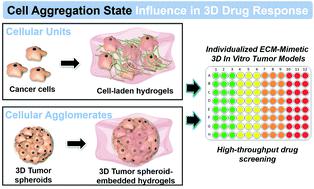当前位置:
X-MOL 学术
›
Biomater. Sci.
›
论文详情
Our official English website, www.x-mol.net, welcomes your
feedback! (Note: you will need to create a separate account there.)
Hydrogel 3D in vitro tumor models for screening cell aggregation mediated drug response.
Biomaterials Science ( IF 5.8 ) Pub Date : 2020-02-17 , DOI: 10.1039/c9bm02075f Maria V Monteiro 1 , Vítor M Gaspar 1 , Luís P Ferreira 1 , João F Mano 1
Biomaterials Science ( IF 5.8 ) Pub Date : 2020-02-17 , DOI: 10.1039/c9bm02075f Maria V Monteiro 1 , Vítor M Gaspar 1 , Luís P Ferreira 1 , João F Mano 1
Affiliation

|
Hydrogel-based 3D in vitro models comprising tumor ECM-mimetic biomaterials exhibit superlative potential as preclinical testing platforms for drug discovery and bioperformance screening. However, during hydrogel design and testing stages, the ideal selection between cancer cell laden 3D models or spheroid embedded hydrogel platforms remains to be elucidated. Selecting a disease-mimicking cellular arrangement within ECM hydrogels is paramount for anti-cancer therapeutics performance evaluation and may lead to differential outcomes. To investigate the effects assigned to varying cellular-arrangement, we developed dense 3D spheroid microtumors and cell-laden MG-63 osteosarcoma platforms embedded in GelMA and Matrigel ECM-mimetic scaffolds. These platforms enabled cancer cells/3D microtissues maturation and lorlatinib drug performance screening. Initial 3D spheroids assembly via the liquid overlay technique, resulted in the fabrication of dense cellular aggregates with reproducible size, morphology and necrotic core formation, thus mimicking the native tumor. Upon in vitro maturation, MG-63 spheroids encapsulated in hydrogel scaffolds exhibited significantly higher invasion and drug resistance than their cell laden hydrogel counterparts. Such data reveals inherent physiological and drug response variances among randomly distributed osteosarcoma cells and 3D spheroid-laden hydrogels. Overall, this highlights the importance of evaluating different cellular aggregation states when designing ECM-mimetic hydrogels for in vitro tumor modeling and high-throughput screening of anti-cancer therapeutics.
中文翻译:

用于筛选细胞聚集介导的药物反应的水凝胶3D体外肿瘤模型。
基于水凝胶的3D体外模型,包括模拟肿瘤ECM的生物材料,具有作为药物发现和生物性能筛选的临床前测试平台的最高潜力。但是,在水凝胶设计和测试阶段,仍然需要阐明在载有癌细胞的3D模型或球状嵌入式水凝胶平台之间的理想选择。在ECM水凝胶中选择模仿疾病的细胞排列对于评估抗癌治疗性能至关重要,并且可能导致不同的结果。为了研究分配给不同细胞排列的效应,我们开发了密集的3D球形微肿瘤和载有GelMA和Matrigel ECM模拟支架的载有细胞的MG-63骨肉瘤平台。这些平台使癌细胞/ 3D微组织成熟和lorlatinib药物性能筛选成为可能。通过液体覆盖技术进行的初始3D球体组装,导致了密集的细胞聚集体的制造,其大小,形态和坏死核的形成均具有可复制性,从而模仿了天然肿瘤。在体外成熟时,封装在水凝胶支架中的MG-63球体比其充满细胞的水凝胶对应物具有更高的侵袭性和耐药性。此类数据揭示了随机分布的骨肉瘤细胞和3D球状水凝胶之间固有的生理和药物反应差异。总的来说,这凸显了在设计用于体外肿瘤建模和高通量抗癌治疗药物设计ECM模拟水凝胶时评估不同细胞聚集状态的重要性。导致了具有可复制的大小,形态和坏死核心形成的致密细胞聚集体的制造,从而模仿了天然肿瘤。在体外成熟时,封装在水凝胶支架中的MG-63球体比其充满细胞的水凝胶对应物具有更高的侵袭性和耐药性。此类数据揭示了随机分布的骨肉瘤细胞和3D球状水凝胶之间固有的生理和药物反应差异。总的来说,这凸显了在设计用于体外肿瘤建模和高通量抗癌治疗药物设计ECM模拟水凝胶时评估不同细胞聚集状态的重要性。导致了具有可复制的大小,形态和坏死核心形成的致密细胞聚集体的制造,从而模仿了天然肿瘤。在体外成熟时,封装在水凝胶支架中的MG-63球体比其充满细胞的水凝胶对应物具有更高的侵袭性和耐药性。此类数据揭示了随机分布的骨肉瘤细胞和3D球状水凝胶之间固有的生理和药物反应差异。总的来说,这凸显了在设计用于体外肿瘤建模和高通量抗癌治疗药物设计ECM模拟水凝胶时评估不同细胞聚集状态的重要性。封装在水凝胶支架中的MG-63球状体比含细胞的水凝胶对应物具有更高的侵袭性和耐药性。此类数据揭示了随机分布的骨肉瘤细胞和3D球状水凝胶之间固有的生理和药物反应差异。总的来说,这凸显了在设计用于体外肿瘤建模和高通量抗癌治疗药物设计ECM模拟水凝胶时评估不同细胞聚集状态的重要性。封装在水凝胶支架中的MG-63球状体比含细胞的水凝胶对应物具有更高的侵袭性和耐药性。此类数据揭示了随机分布的骨肉瘤细胞和3D球状水凝胶之间固有的生理和药物反应差异。总的来说,这凸显了在设计用于体外肿瘤建模和高通量抗癌治疗药物设计ECM模拟水凝胶时评估不同细胞聚集状态的重要性。
更新日期:2020-02-17
中文翻译:

用于筛选细胞聚集介导的药物反应的水凝胶3D体外肿瘤模型。
基于水凝胶的3D体外模型,包括模拟肿瘤ECM的生物材料,具有作为药物发现和生物性能筛选的临床前测试平台的最高潜力。但是,在水凝胶设计和测试阶段,仍然需要阐明在载有癌细胞的3D模型或球状嵌入式水凝胶平台之间的理想选择。在ECM水凝胶中选择模仿疾病的细胞排列对于评估抗癌治疗性能至关重要,并且可能导致不同的结果。为了研究分配给不同细胞排列的效应,我们开发了密集的3D球形微肿瘤和载有GelMA和Matrigel ECM模拟支架的载有细胞的MG-63骨肉瘤平台。这些平台使癌细胞/ 3D微组织成熟和lorlatinib药物性能筛选成为可能。通过液体覆盖技术进行的初始3D球体组装,导致了密集的细胞聚集体的制造,其大小,形态和坏死核的形成均具有可复制性,从而模仿了天然肿瘤。在体外成熟时,封装在水凝胶支架中的MG-63球体比其充满细胞的水凝胶对应物具有更高的侵袭性和耐药性。此类数据揭示了随机分布的骨肉瘤细胞和3D球状水凝胶之间固有的生理和药物反应差异。总的来说,这凸显了在设计用于体外肿瘤建模和高通量抗癌治疗药物设计ECM模拟水凝胶时评估不同细胞聚集状态的重要性。导致了具有可复制的大小,形态和坏死核心形成的致密细胞聚集体的制造,从而模仿了天然肿瘤。在体外成熟时,封装在水凝胶支架中的MG-63球体比其充满细胞的水凝胶对应物具有更高的侵袭性和耐药性。此类数据揭示了随机分布的骨肉瘤细胞和3D球状水凝胶之间固有的生理和药物反应差异。总的来说,这凸显了在设计用于体外肿瘤建模和高通量抗癌治疗药物设计ECM模拟水凝胶时评估不同细胞聚集状态的重要性。导致了具有可复制的大小,形态和坏死核心形成的致密细胞聚集体的制造,从而模仿了天然肿瘤。在体外成熟时,封装在水凝胶支架中的MG-63球体比其充满细胞的水凝胶对应物具有更高的侵袭性和耐药性。此类数据揭示了随机分布的骨肉瘤细胞和3D球状水凝胶之间固有的生理和药物反应差异。总的来说,这凸显了在设计用于体外肿瘤建模和高通量抗癌治疗药物设计ECM模拟水凝胶时评估不同细胞聚集状态的重要性。封装在水凝胶支架中的MG-63球状体比含细胞的水凝胶对应物具有更高的侵袭性和耐药性。此类数据揭示了随机分布的骨肉瘤细胞和3D球状水凝胶之间固有的生理和药物反应差异。总的来说,这凸显了在设计用于体外肿瘤建模和高通量抗癌治疗药物设计ECM模拟水凝胶时评估不同细胞聚集状态的重要性。封装在水凝胶支架中的MG-63球状体比含细胞的水凝胶对应物具有更高的侵袭性和耐药性。此类数据揭示了随机分布的骨肉瘤细胞和3D球状水凝胶之间固有的生理和药物反应差异。总的来说,这凸显了在设计用于体外肿瘤建模和高通量抗癌治疗药物设计ECM模拟水凝胶时评估不同细胞聚集状态的重要性。









































 京公网安备 11010802027423号
京公网安备 11010802027423号